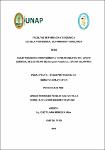| dc.contributor.advisor | Jara Herrera, Cleto | |
| dc.contributor.author | Canayo Tello, Apeles Perickles Teoklio | |
| dc.contributor.author | Ramirez Reátegui, Fiorella Del Rocio | |
| dc.date.accessioned | 2023-08-28T17:36:08Z | |
| dc.date.available | 2023-08-28T17:36:08Z | |
| dc.date.issued | 2023 | |
| dc.identifier.other | 547.045 C23 2023 | |
| dc.identifier.uri | https://hdl.handle.net/20.500.12737/9301 | |
| dc.description.abstract | Eryngium foetidium of the Apiaceae family is used as a condiment in the preparation of food in the regional Amazonian cuisine. in addition, because it possesses bioactive molecules, it is used in traditional medicine as an antiflatulent, antibacterial, antipyretic, analgesic, anti-influenza, and antinociceptive. This study aimed to characterize the essential oil extracted from E. foetidium leaves by hydrodistillation in a Karlsruhe apparatus. It was characterized by the determination of physicochemical properties and by gas chromatographic analysis coupled to a mass spectrometer, giving the following results: density 0.8686 g/cm3, refractive index 1.456 and the color reaction for aldehydes and esters gave a yield of 0.107%. By GC-MS analysis, 6 components were identified which in order of abundance 2-Dodecanal is 58.13%, Hexadecanoic acid ethyl ester 16.82%, unknown (C14H26O) 11.12%, and Nonadecane 6.86%., The essential oil of E. foetidum from the Peruvian Amazon because it contains 58.13% 2-dodecanal, in addition to its use in cooking as a seasoning, may have greater application in the pharmaceutical industry for its anthelmintic, antibacterial, and fungicidal properties of these aldehydes, being another important option that can be applied in cosmetics to make toilet soaps and finally as an ecological fuel. | en_US |
| dc.description.abstract | Eryngium foetidium de la familia Apiaceae, es usado como condimento en la preparación de alimentos en la culinaria regional amazónica. además, por poseer moléculas bioactivas es utilizado en la medicina tradicional como antiflatulento, antibacteriano, antipirético, analgésico, antigripal y antinociceptivo. El objetivo de este estudio fue caracterizar el aceite esencial extraído de las hojas de E. foetidium por hidrodestilación en un equipo de Karlsruhe. Se caracterizó por determinación de las propiedades fisicoquímicas y mediante análisis por cromatografía de gases acoplado a un espectrómetro de masas, dando los resultados siguientes: densidad 0,8686 g/cm, Índice de refracción 1,456 y la reacción colorida para aldehídos y ésteres dio, el rendimiento fue de 0,107%. Por análisis CG-MS, se identificó 6 componentes que en orden de abundancia el 2-Dodecanal es de 58,13%, Etil éster del ácido hexadecanoico 16,82%, desconocido (C14H26O) 11,12% y Nonadecano 6,86%., El aceite esencial de E. foetidum de la Amazonía peruana por contener 58,13% de 2-dodecanal, además de su uso en culinaria como sazonador, puede tener mayor aplicación en la industria farmacéutica sus propiedades antihelmínticas, antibacterial y fungicida de estos aldehídos , siendo otra opción importante el que pueda aplicarse en cosmética para elaborar jabones de tocador y por último como combustible ecológico. | es_PE |
| dc.format | application/pdf | es_PE |
| dc.language.iso | spa | es_PE |
| dc.publisher | Universidad Nacional de la Amazonía Peruana | es_PE |
| dc.rights | info:eu-repo/semantics/openAccess | * |
| dc.rights.uri | https://creativecommons.org/licenses/by/4.0/ | * |
| dc.subject | Propiedades fisicoquímicas | es_PE |
| dc.subject | Cromatografía de gases | es_PE |
| dc.subject | Espectrometría de masas | es_PE |
| dc.subject | Aceites esenciales | es_PE |
| dc.subject | Sacha culantro | es_PE |
| dc.subject | Eryngium foetidium | es_PE |
| dc.title | Caracterización fisicoquímico y cromatográfica del aceite esencial de las hojas de Eryngium foetidum L. (sacha culantro) | es_PE |
| dc.type | info:eu-repo/semantics/bachelorThesis | es_PE |
| thesis.degree.discipline | Farmacia y Bioquímica | es_PE |
| thesis.degree.grantor | Universidad Nacional de la Amazonía Peruana. Facultad de Farmacia y Bioquímica | es_PE |
| thesis.degree.name | Químico(a) Farmacéutico(a) | es_PE |
| dc.subject.ocde | https://purl.org/pe-repo/ocde/ford#1.04.01 | es_PE |
| renati.author.dni | 45612764 | |
| renati.author.dni | 46297846 | |
| renati.advisor.orcid | https://orcid.org/0000-0003-4402-8315 | |
| renati.advisor.dni | 05290666 | |
| renati.type | https://purl.org/pe-repo/renati/type#tesis | es_PE |
| renati.discipline | 917046 | es_PE |
| renati.level | https://purl.org/pe-repo/renati/level#tituloProfesional | es_PE |
| renati.juror | Urday Ruiz, Brenda Soraya | |
| renati.juror | Maco Luján, Martha Milagros | |
| renati.juror | Fernández Arellano, Lenin | |
| dc.publisher.country | PE | es_PE |





